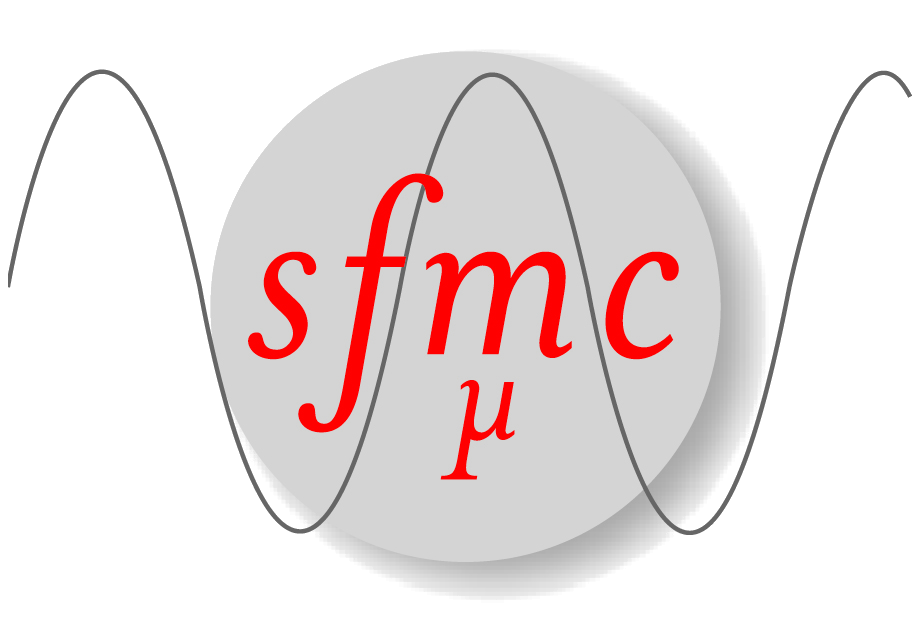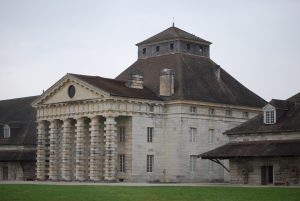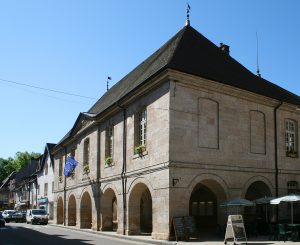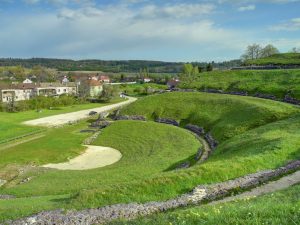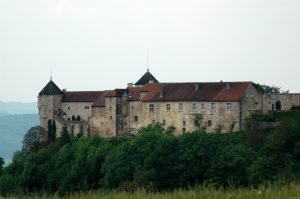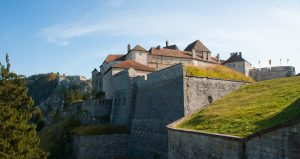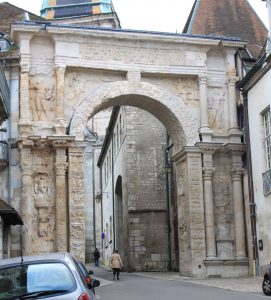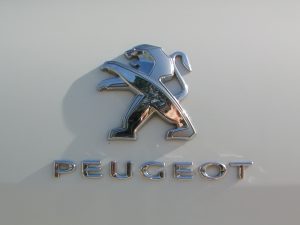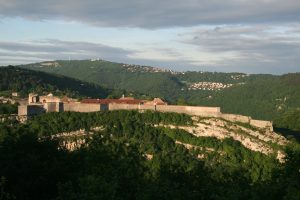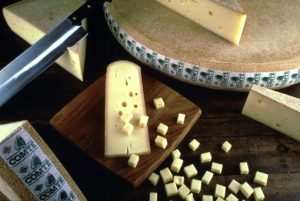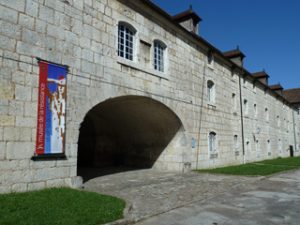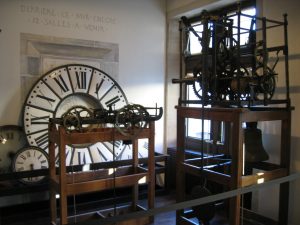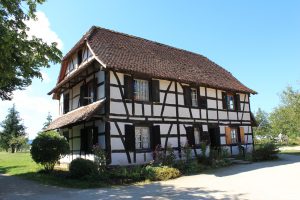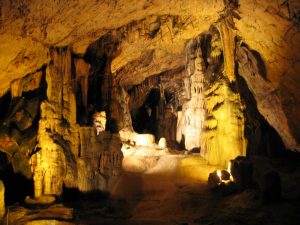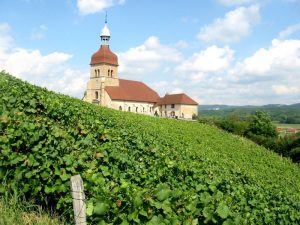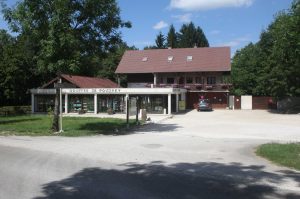Places of interest
Anyone could spend hours walking around the streets of the beautiful town centre of Besançon, but there are many interesting sites around the city that owe to be visited. Besides, going to those sites will let you go through Franche-Comté’s beautiful landscape, from the plains of the Saone River, to the forests and mountains of the Jura, with it’s lakes, points of view and natural reserves.
Saline Royale d’Arc-et-Senans
The Royal Saltworks of Arc-et-Senans, near Besançon, were built by Claude-Nicolas Ledoux. Its construction, begun in 1775 during the reign of Louis XVI, was the first major achievement of industrial architecture, reflecting the ideal of progress of the Enlightenment era. This vast, semicircular complex was designed to permit a rational and hierarchical organization of work and was to be followed by the building of an ideal city, a project that was never realized. Today, we can see how salt was extracted and brought to the Saltworks in the 18th century, and the different stages of the transformation of the salted water (saumure) into salt. A permanent exhibition depicts the life and works of Ledoux, a forerunner in modern city planning. This site is inscribed on the World Heritage List of the UNESCO.
Website : www.salineroyale.com
Contact : +33 (0)3 81 54 45 45
Ville d’Ornans
Ornans is a very interesting and picturesque small town on the Loue River, with well preserved buildings from the 16th century (city hall, townhouses) and a 12th century church. It is the hometown of Gustave Courbet and hosts a small museum dedicated to this great painter and sculptor of the 19th century. The remarkable interest of Ornans is it’s finely decorated houses and restaurants overhanging the Loue River.
Website : www.ornans.fr
Contact : 03 81 62 40 30
Théâtre Romain de Mandeure
Highway A36 to Mandeure.
Contact : 03 81 31 87 80
Château de Belvoir
Belvoir is an entirely restored medieval fortress of the 12th and 13th centuries. The visit takes you to all the rooms of the castle, including the arsenal, the reception room, and the living quarters of the former inhabitants. A huge medieval arms collection includes a unique chainmail armor of the 12th century. In one of the rooms you will also discover a stone-carved cupboard, typical piece of Comtois rural art of the Middle-Ages.
Website : www.chateau-belvoir.com
Contact : 06 70 28 16 52
Château de Joux
The fortress of Joux represents a fairly interesting view of the evolution of military architecture, from it’s medieval towers to the half-burried fortress of the 19th century. It hosts one of Europe’s deepest wells, and the largest French museum for arms and uniforms, with collections dating from the 18th century to World War I.
Website : www.chateaudejoux.com
Contact : 03 81 69 47 95
La Porte Noire et le Square Castan
The Porte Noire (Black Gate) is one of the biggest Roman triumphal arch in France. It’s colour is due to the fire that devastated the granary it hosted in the Middle-Ages. Dating back to the 2nd century, the arch was erected under emperor Marcus-Aurelius and is remarkable for the size of it’s sculptures, representing divinities and scenes of fighting. Just a few metres away stand the ruins of a Roman water-tank that collected springwater from Arcier (east of Besançon), via an aqueduct of 15 kilometres.
Situated Rue de la Convention, town centre of Besançon.
Website : www.besac.com/laportenoire
Contact : –
Musée Peugeot
Peugeot, one of France’s largest vehicle manufacturer, now has its own museum for automobiles, but also for all kinds of products the company has manufactured in its past (bicycles, firearms, sewing machines…). Racing cars and protoypes are also on exhibit, totalising near 100 models of vehicles from various periods. The site of the museum, Sochaux, is the hometown of Peugeot.
Website : www.museepeugeot.com
Contact : 03 81 99 42 03
Histoire Naturelle
The museum of Natural History is hosted by the Citadel. It includes a large Zoo, an aquarium, an insectarium, and many collections. A well furnished butterflies collection, local wildlife animals as well as exotic ones, combine to make of this museum a very attractive place to visit.
Website : www.citadelle.com
Contact : 03 81 87 83 33
Musée-Fromagerie de Trepot
The old cheese-dairy co-operative of Trepot in activity from 1818 to 1977 has evolved into a local museum for cheese and all the activities related to it. The visit includes an explanation of the processing stages of the Comté cheese, the region’s reknowned speciality.
N57 to Saone, then Tarcenay and Trepot.
Website : www.fromagerie-trepot.fr
Contact : 03 81 86 71 06
Résistance et Déportation
Also hosted by the Citadel, the museum of Resistance and Deportation is unique in France. It evokes the exactions of all kinds committed during World War II. There is also a special room that shows art works made by prisonners of concentration camps during their imprisonment that reveals their fears and thoughts. Contemporary works inspired by this period are also exposed.
Website : www.citadelle.com
Contact : 03 81 87 83 33
Musée du Temps
Besançon’s watchmaking past deserved a museum that would depict all the aspects of horology. This is now done with this quite recent Museum of Time. Collections of Watches, Comtoises Clocks and exhibitions about the glorious industrious past of the city and the region in the domain of time, show the world of precision often unknown of this noble industry.
Website : www.mdt.besancon.fr
Contact : +33 381 878 161
Maisons Comtoises de Nancray
This outdoor ever growing museum depicts the evolution of local housing, with ancient farms and rural houses, like the « Tuyé » farm, used for the smoking and conservation of meat. All the houses were dismantled in their original village, and brought to the site of the museum to be re-built there, with their original landscape and environment. They are all completely furnished and give a real view of what our ancestors living conditions were.
Website : www.maisons-comtoises.org
Contact : 03 81 55 23 97
Grottes d’Osselle
Discovered during the Middle-Ages (used at that time for refuge) and explorated for centuries afterwards, the Osselle karst Caves are considered one of the most fascinating natural sites in Europe. Coloured caves of various shapes, « forests » of stalagmites and stalagtites, an underground river, offer the visitor a wonderful show for the eyes and the mind in an unsuspected atmosphere.
Website : www.grottes.osselle.fr
Contact : 03.81.63.62.09
Vignoble Jurassien
With the first french wine A.O.C. (wines of verified origin and quality), the vineyards of Jura are still mostly unknown, even in France. Dating back to the Roman period and the Middle-Ages, local wines used to be reknowned at the courts of France and the Empire. Although it was weakened by the two world wars and the Phylloxera, Jura still produces wines of high quality in small quantities (like the famous « Vin Jaune » or Yellow Wine) with very few exports, so that locals can keep it for themselves… ;).
Website:
www.chateau-bethanie.com
Contact : 03 84 66 11 67
Gouffre de Poudrey
Discovered in 1899, the Poudrey Chasm is one of the most impressive natural attractions of the region. It is more than 100 meters deep and has one of the biggest subterranean halls in Europe (600 meters of circumference and 60 meters in height). You will discover there beautiful limestone formations (enormous stalagmites, etc…) and a small underground lake, formed by moisture water. The music that will accompany you (mostly Wagner and Jean-Michel Jarre) will add to the mistery of this site.
Website : www.gouffredepoudrey.com
Contact : 03 81 59 27 05



